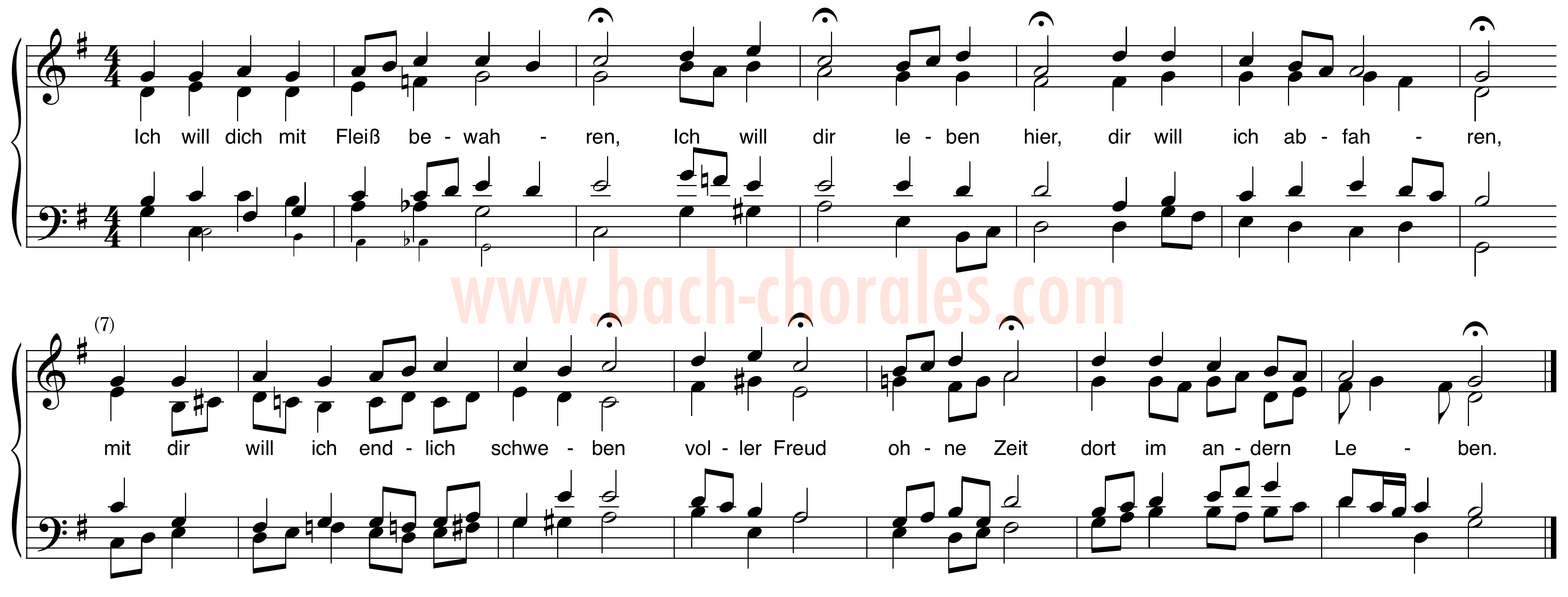 |





|
BWV 248(3).33(10)

Previous: BWV 248.28
Next: BWV 248.35
Original source: Oratorio, Christmas Oratorio, part 3, BWV 248 (bach–digital page)
Chorale Text: Fröhlich soll mein Herze springen (verse 15), by Paul Gerhardt (1653)
Tune: Warum sollt ich mich denn grämen, by Georg Ebeling (1666) (Zahn 6461)
First Performance: 27 December 1734, 3rd Day of Christmas
Appearance in Early Collections (Key):
Riemenschneider 139;
Breitkopf 139;
Birnstiel 143;
Dietel 125;
AmB 46II p.86 & p.116;
Penzel 155
Other Harmonizations: BWV
422
Instrumentation: Colla parte — S: violin 1, transverse flute 1 & 2 (8va), oboe 1 & 2. A: violin 2. T: viola. B: cello, organ, continuo.
Original manuscripts
Score: D–B Mus. ms. Bach P 32
Parts:
Part 1 — D–B Mus. ms. Bach St 112I, Faszikel 1
Part 2 — D–B Mus. ms. Bach St 112II, Faszikel 1
Part 3 — D–B Mus. ms. Bach St 112III, Faszikel 1
Part 4 — D–B Mus. ms. Bach St 112IV, Faszikel 1
Part 5 — D–B Mus. ms. Bach St 112V, Faszikel 1
Part 6 — D–B Mus. ms. Bach St 112VI, Faszikel 1
Notes
Measure 2 contains parallel fifths between the soprano (B–C) and alto (E–F), created by a passing tone in the S. While these parallels in this chorale appear in the original manuscripts, they have been "corrected" in some of the 18th c. chorale collections assembled after Bach’s death. In the important Breitkopf edition published in the 1780s and edited primarily by C.P.E. Bach, the parallels have been eliminated by substituting the alto’s downbeat E for an F#. Harmonically, the F# works, converting a root position A minor chord (ii in the beginning key of G) into a first inversion F# diminished (viio6). And the alto’s F#–F chromatic descent might be thought to match that of the bass (A–Ab). Still, taken as an entire phrase, the alto’s F# significantly impedes its directed upward motion — the line D–F#–F–G is certainly less compelling than D–E–F–G.
Breitkopf Edition, Volume 2 (1785)

The same correction is present in the first appearance of the chorale in the earlier AmB 46II manuscript on p.86, though the parallels are left uncorrected in the second appearance of the chorale in that collection on p.116. (Modern editions of the Riemenschneider and Breitkopf generally include the original E downbeat.)
The editorial inconsistencies between these early chorale collections are rather curious and reflect a strikingly liberal editorial methodology. It is difficult to say who is responsible for such editorial emendations. Simply assuming that C.P.E. Bach as primary editor of the Breitkopf is the principal culprit, as some have certainly assumed, fails to take into account the other early chorale collections that contain similar emendations, collections like the AmB 46II and Fasch manuscripts, both of which predate the Breitkopf and both which were quite possibly edited by someone other than C.P.E. Bach. Other potential culprits include Johann Kirnberger (who had a known association with "Anonymous J.S. Bach VI," the copyist of the AmB 46II manuscript), Friedrich Marpurg (who edited the early parts of the 1765 Birnstiel publication which served as a template for the Breitkopf) among other former students of J.S. Bach who were perhaps interested in enhancing the legacy of their great teacher as a master contrapuntalist.
For a complete account of consecutive fifths and octaves in the Bach chorales, see "Consecutive Fifths & Octaves in the Bach Chorales" featured on the Articles & Research page.
bach–chorales.com by Luke Dahn. Copyright 2018.